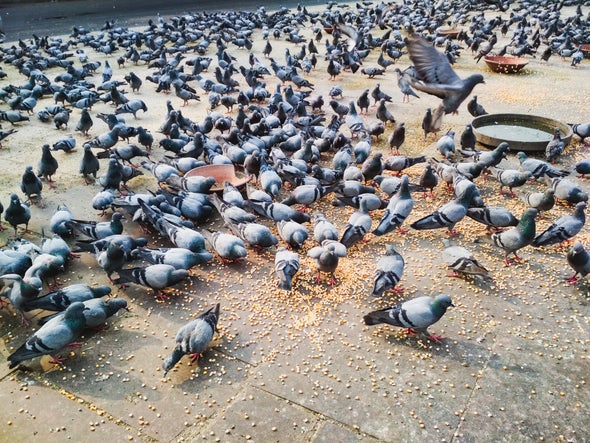(单词翻译:单击)
听力文本
This is Scientific American's 60-second Science, I'm Susanne Bard.
As long as humans have been building cities, wildlife has been fleeing from them. After all, cities are noisy, crowded and dangerous for animals—including many birds. But we know that some birds do very well in urban areas.
"So in many cities, we have pigeons or doves, any kind of crow species."
University of Gothenburg biologist Ferran Sayol. He and his colleagues are interested in why some birds thrive in urban environments. They suspected that having a large brain in relation to overall body size could be an advantage.
"Having a big brain gives you more behavioral flexibility. So, for instance, in cities, maybe these big-brained species are better able to identify opportunities for finding food—also, to identify dangers in the city."
But this scenario doesn't account for birds like pigeons—which are decidedly lacking in the brainpower department.

Sayol and his colleagues analyzed the relative brain sizes of 629 bird species from 27 cities around the world, as well as their tolerance for urban life. They found that birds that flourish in cities come in two extremes: they're either big-brained but produce few offspring over their lifetime or they're small-brained and superfertile.
"So, then, this means that we have these two opposing strategies. So for species that have a low frequency of reproduction, if they have a large brain, they are good urban dwellers. Or you have a small brain, but you reproduce frequently. For example, pigeons: if they start breeding and if they lose these eggs, then they can start to breed again almost immediately. It's like spreading the risk. So if you lose one, it's not a big deal."
Sayol says that both of these extreme examples of what are technically known as life-history strategies tend to be uncommon in nature.
"When we go to the city, we start to see that the few species that have these strategies become more and more abundant."
Meanwhile, in natural habitats, the vast majority of birds have average-sized brains.
"The ones that have average brains, they are less and less abundant in cities."
The study is in the journal Frontiers in Ecology and Evolution.
Understanding how brain size, behavioral flexibility and life history traits interact can help researchers predict how species will respond to a rapidly urbanizing planet, where survival can mean taking it to the extremes.
Thanks for listening for Scientific American's 60-second Science. I'm Susanne Bard.
参考译文
这里是科学美国人——60秒科学系列,我是苏珊娜·巴德。
只要人类还在建造城市,野生动物就会继续逃离。毕竟对包括许多鸟类在内的动物来说,城市嘈杂、拥挤,而且危险。但我们知道有些鸟类在城市地区生活得很好。
“许多城市都有鸽子以及各个种类的乌鸦。”
哥德堡大学的生物学家费兰·萨约尔说到。他和同事对有些鸟类在城市环境中繁衍生息的原因很感兴趣。他们怀疑,脑体积在整体体型中占比较大,可能是个优势。
“脑体积大,行为会更加灵活。举例来说,在城市里,也许脑体积大的物种能够更好地识别出发现食物的机会,也能更好地识别出城市中的危险。”
但这种情况并不能解释鸽子等鸟类的情况,因为它们明显缺乏智力。
萨约尔及其同事分析了世界27个城市629种鸟类的相对脑容量,以及它们对城市生活的耐受性。他们发现,在城市繁衍生息的鸟类呈现出两种极端:要么脑容量大但一生很少孕育后代,要么是脑容量小但生育能力超强。
“这就意味着我们有两种相反的策略。对于繁殖率较低的物种来说,如果它们脑容量大,那它们就是优秀的城市居民。或者脑容量小,但繁殖率非常高。比如鸽子,如果它们开始繁殖,即使丢了蛋,它们几乎可以立即开始再繁殖。就像是分散风险。即使丢了一个蛋,也没什么。”
萨约尔表示,在学术上称为“生活史策略”的这两种极端例子,在自然中往往并不常见。
“我们走进城市,开始看到使用这些策略的少数物种,它们的数量正在逐渐扩大。”
同时,在自然栖息地中,绝大多数鸟类的脑体积都是中等大小。
“脑体积中等的鸟类,在城市里的数量越来越少。”
这项研究发表在《生态学与进化前沿》杂志上。
了解脑体积、行为灵活性和生活史特征之间的相互作用,有助于研究人员预测物种会如何应对快速城市化的地球,而在那里,生存可能意味着走向极端。
谢谢大家收听科学美国人——60秒科学。我是苏珊娜·巴德。
译文为可可英语翻译,未经授权请勿转载!
重点讲解
重点讲解:
1. as long as 只要;
As long as you have your health, nothing else matters.
只要身体健康,其他任何事都无关紧要。
2. after all 毕竟;终究;
After all, 15 minutes of exercise is better than nothing.
毕竟,锻炼15分钟比不锻炼好。
3. in relation to 与…相比;
The money he'd been ordered to pay was minimal in relation to his salary.
他被要求支付的金额与他的薪水相比微不足道。
4. account for 导致;解释;
Now, the gene they discovered today doesn't account for all those cases.
不过,他们现在发现的基因无法解释所有的病例。


